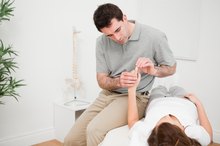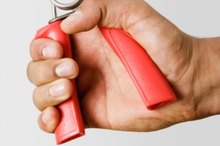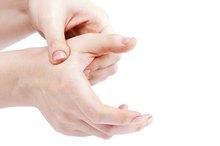What does fact checked mean?
At Healthfully, we strive to deliver objective content that is accurate and up-to-date. Our team periodically reviews articles in order to ensure content quality. The sources cited below consist of evidence from peer-reviewed journals, prominent medical organizations, academic associations, and government data.
The information contained on this site is for informational purposes only, and should not be used as a substitute for the advice of a professional health care provider. Please check with the appropriate physician regarding health questions and concerns. Although we strive to deliver accurate and up-to-date information, no guarantee to that effect is made.
Trigger Finger Exercises
Trigger finger, or stenosing tenosynovitis, is caused by a narrowing of the sheath that surrounds the tendon in the affected finger 1. The symptoms of this condition include finger stiffness, popping or clicking when you move your finger, tenderness or pain in the affected knuckle and the affected finger catching or locking in a bent position. There are several treatment options for trigger finger including rest, splinting, medication and massage 1. The Mayo Clinic notes that gentle exercises may help maintain mobility in your finger. Consult your health care provider before beginning a new exercise program.
If you are experiencing serious medical symptoms, seek emergency treatment immediately.
Self-Massage
Massaging the affected knuckle will facilitate blood flow to the area, which will lubricate the joint and prepare it for movement. With your affected finger in a comfortable position, begin to gently rub across the knuckle then rub in a circular motion. Continue the self-massage for two to three minutes and follow with range-of-motion exercises.
Assisted Movement
Dupuytren's Contracture Exercises
Learn More
Assisted movement exercises will help maintain and even improve range of motion in your affected finger. Use your other hand to slowly and gently bend and straighten your affected finger, moving it through the largest range of motion possible. Bend and straighten your finger 10 to 15 times.
Stretching
Stretching your finger is important not only for your muscles but also for the tendons and ligaments in your affected finger. Keeping the connective tissue as flexible as possible is important in the treatment of trigger finger 1. Use your other hand to pull your affected finger beyond extension until you feel a stretch in the bottom of your finger. Hold the stretch for five to 10 seconds then stretch your finger in the other direction. Repeat each stretch three to five times.
- Stretching your finger is important not only for your muscles but also for the tendons and ligaments in your affected finger.
- Hold the stretch for five to 10 seconds then stretch your finger in the other direction.
Strengthening Exercises
Trigger Finger Surgery Rehabilitation
Learn More
Trigger finger is common among individuals who repetitively grip objects 1. Gripping is performed by your flexor muscles, which means your extensor muscles may be weak causing a muscle imbalance. Strengthening these muscles may help in the treatment of trigger finger 1. Keeping your fingers straight, bend your knuckles so that your hand forms a 90-degree angle. Press your thumb close to your fingers then wrap a thick rubber band around your fingers and thumb. Working against the resistance of the rubber band, open your hand by extending your fingers as much as possible. Slowly return to the starting position. Repeat the exercise 10 to 15 times.
- Trigger finger is common among individuals who repetitively grip objects 1.
- Keeping your fingers straight, bend your knuckles so that your hand forms a 90-degree angle.
Related Articles
References
- MayoClinic.com: Trigger Finger
- SelfGrowth.com: Eradicate Trigger Finger with Flextend Exercises
- American Academy of Orthopaedic Surgeons: Trigger Finger
- Repetitive Strain Injury-Relief: Trigger Finger
- Van veenendaal LM, De klerk G, Van der velde D. A painful finger as first sign of a malignancy. Geriatr Orthop Surg Rehabil. 2014;5(1):18-20. doi:10.1177/2151458514522125
- Oetgen ME, Dodds SD. Non-operative treatment of common finger injuries. Curr Rev Musculoskelet Med. 2008;1(2):97-102. doi:10.1007/s12178-007-9014-z
- Prucz RB, Friedrich JB. Finger joint injuries. Clin Sports Med. 2015;34(1):99-116. doi:10.1016/j.csm.2014.09.002
- Christensen T, Sarfani S, Shin AY, Kakar S. Long-term outcomes of primary repair of chronic thumb ulnar collateral ligament injuries. Hand (N Y). 2016;11(3):303-309. doi:10.1177/1558944716628482
- Spies CK, Langer M, Hahn P, Müller LP, Unglaub F. The treatment of primary arthritis of the finger and thumb joint. Dtsch Arztebl Int. 2018;115(16):269-275. doi:10.3238/arztebl.2018.0269
- Deveza LA, Hunter DJ, Wajon A, et al. Efficacy of combined conservative therapies on clinical outcomes in patients with thumb base osteoarthritis: protocol for a randomised, controlled trial (COMBO). BMJ Open. 2017;7(1):e014498. doi:10.1136/bmjopen-2016-014498
- Makkouk AH, Oetgen ME, Swigart CR, Dodds SD. Trigger finger: etiology, evaluation, and treatment. Curr Rev Musculoskelet Med. 2008;1(2):92-6. doi:10.1007/s12178-007-9012-1
- Alla SR, Deal ND, Dempsey IJ. Current concepts: mallet finger. Hand (N Y). 2014;9(2):138-44. doi:10.1007/s11552-014-9609-y
Writer Bio
Jen Weir writes for several websites, specializing in the health and fitness field. She holds a Bachelor of Science in exercise science from Montana State University, is an NSCA-certified strength and conditioning specialist and maintains a personal trainer certification from the American College of Sports Medicine.









